

Url?sa=t&rct=j&q=ghost%20fishing&source=web&cd=7&ved=0CCcQFjAG&url=http%3A%2F%2Foceanservice.noaa.gov%2Ffacts%2Fghostfishing. Whaling. Whaling is the hunting of whales primarily for meat and oil.
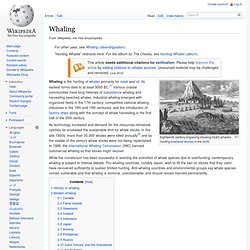
Its earliest forms date to at least 3000 BC.[1] Various coastal communities have long histories of subsistence whaling and harvesting beached whales. Industrial whaling emerged with organized fleets in the 17th century; competitive national whaling industries in the 18th and 19th centuries; and the introduction of factory ships along with the concept of whale harvesting in the first half of the 20th century. What is overfishing for children? What is overfishing?
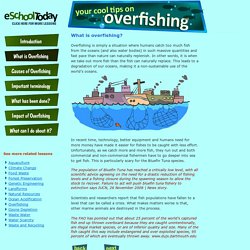
Overfishing is simply a situation where humans catch too much fish from the oceans (and also water bodies) in such massive quantities and fast pace than nature can naturally replenish. Url?sa=t&rct=j&q=&esrc=s&source=web&cd=12&ved=0CAwQFjABOAo&url=http%3A%2F%2Fsaveourseas. Global Warming and its Effect on Marine Populations - An Overview of Global Warming in the Ocean. Global warming, an increase in the earth's average atmospheric temperature that causes corresponding changes in climate, is a growing environmental issue caused by the influx of human industry and agriculture in the mid-twentieth-century to the present.

As greenhouse gases such as CO2 and methane are released into the atmosphere, a shield forms around our Earth, trapping heat inside of our planet and therefore creating a general warming effect. One of the most influenced territories of warming has been our oceans. Rising air temperatures affect the physical nature of our oceans. Why is overfishing a global concern?
The problem of Overfishing We all love to eat fish, don’t we?
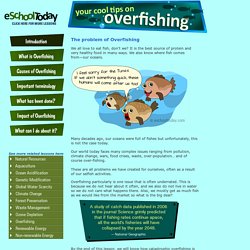
It is the best source of protein and very healthy food in many ways. We also know where fish comes from—our oceans. Many decades ago, our oceans were full of fishes but unfortunately, this is not the case today. Our world today faces many complex issues ranging from pollution, climate change, wars, food crises, waste, over-population… and of course over-fishing. These are all problems we have created for ourselves, often as a result of our selfish activities. Sea Temperature Rise. As climate change has warmed the Earth, oceans have responded more slowly than land environments.

But scientific research is finding that marine ecosystems can be far more sensitive to even the most modest temperature change. Global warming caused by human activities that emit heat-trapping carbon dioxide has raised the average global temperature by about 1°F (0.6°C) over the past century. In the oceans, this change has only been about 0.18°F (0.1°C). This warming has occurred from the surface to a depth of about 2,300 feet (700 meters), where most marine life thrives. Perhaps the ocean organism most vulnerable to temperature change is coral.
Reef Check's Web Reef Advisory System (WRAS) Fishing. Plastic Pollution in our Oceans. Environmental Issues > Oceans Main Page > All Oceans Documents.
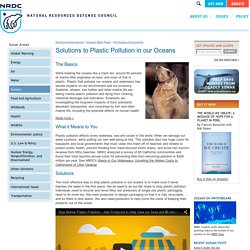
Whaling in Japan. Sea Turtle Threats - Shell Trade. The Problem: Hawksbill sea turtles, recognized for their beautiful gold and brown shells, have been hunted for centuries to create jewelry and other luxury items.
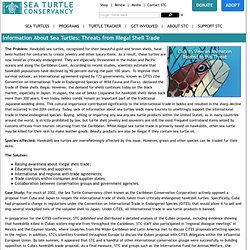
As a result, these turtles are now listed as critically endangered. They are especially threatened in the Indian and Pacific oceans and along the Caribbean Coast. According to recent studies, scientists estimate that hawksbill populations have declined by 90 percent during the past 100 years. To improve their survival outlook, an international agreement signed by 173 governments, known as CITES (the Convention on International Trade in Endangered Species of Wild Fauna and Flora), declared the trade of these shells illegal. However, the demand for shells continues today on the black market, especially in Japan. Species Affected: Hawksbill sea turtles are overwhelmingly affected by this issue. What is a kelp forest? Kelp forests can be seen along much of the west coast of North America.

Kelp are large brown algae that live in cool, relatively shallow waters close to the shore. They grow in dense groupings much like a forest on land. These underwater towers of kelp provide food and shelter for thousands of fish, invertebrates, and marine mammal species. Kelp forests harbor a greater variety and higher diversity of plants and animals than almost any other ocean community.
Many organisms use the thick blades as a safe shelter for their young from predators or even rough storms. Among the many mammals and birds that use kelp forests for protection or feeding include seals, sea lions, whales, sea otters, gulls, terns, snowy egrets, great blue herons, cormorants, and shore birds. These dense canopies of algae generally occur in cold, nutrient-rich waters.
Environmental Threats. Endangered Oceans: Why we should care. A couple of weeks ago I visited the Sea Life Aquarium in London in a hope to check out the tropical fishes and the penguins.

I got more than I had bargained for! What turned out to a casual trip to the Sea Life Aquarium, became an eye opening education for me. Overfishing. Ocean overfishing is simply the taking of wildlife from the sea at rates too high for fished species to replace themselves.
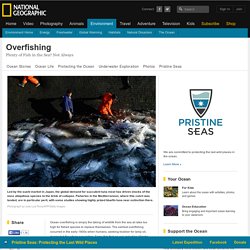
The earliest overfishing occurred in the early 1800s when humans, seeking blubber for lamp oil, decimated the whale population. Some fish that we eat, including Atlantic cod and herring and California's sardines, were also harvested to the brink of extinction by the mid-1900s. Highly disruptive to the food chain, these isolated, regional depletions became global and catastrophic by the late 20th century.